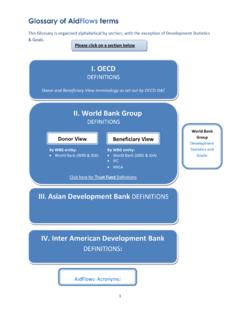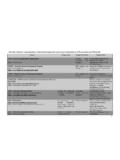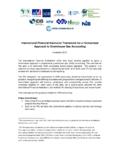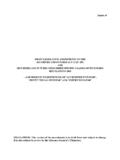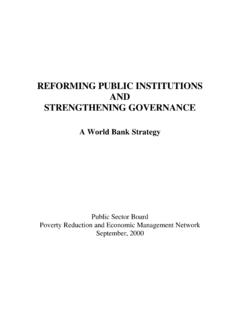Transcription of The Welfare Impact of Rural Electrification: A ...
1 The Welfare Impactof Rural Electrification: A Reassessment of theCosts and BenefitsAn IEG Impact EvaluationThe Welfare Impactof Rural Electrification: A Reassessment of theCosts and BenefitsAn IEG Impact EvaluationTHE WORLD BANKWORKING FOR A WORLD FREE OF POVERTYThe World Bank Group consists of five institutions the international Bank for reconstruction and Development(IBRD), the international Finance Corporation (IFC), the international Development Association (IDA), theMultilateral Investment Guarantee Agency (MIGA), and the international Centre for the Settlement of InvestmentDisputes (ICSID). Its mission is to fight poverty for lasting results and to help people help themselves and theirenvironment by providing resources, sharing knowledge, building capacity, and forging partnerships in the publicand private WORLD BANK GROUPENHANCING DEVELOPMENT EFFECTIVENESS THROUGH EXCELLENCE AND INDEPENDENCE IN EVALUATIONThe Independent Evaluation Group (IEG) is an independent, three-part unit within the World Bank Group.
2 IEG-World Bank is charged with evaluating the activities of the IBRD (the World Bank) and IDA, IEG-IFC focuses onassessment of IFC s work toward private sector development, and IEG-MIGA evaluates the contributions of MIGA guarantee projects and services. IEG reports directly to the Bank s Board of Directors through the Director-General, goals of evaluation are to learn from experience, to provide an objective basis for assessing the results of theBank Group s work, and to provide accountability in the achievement of its objectives. It also improves Bank Groupwork by identifying and disseminating the lessons learned from experience and by framing recommendations drawnfrom evaluation INDEPENDENT EVALUATION GROUPThe Welfare Impact of RuralElectrification: A Reassessmentof the Costs and BenefitsAn IEG Impact EvaluationWORLD BANK INDEPENDENT EVALUATION GROUP2008 The World BankWashington, 2008 The international Bank for reconstruction and Development / The World Bank1818 H Street NWWashington DC 20433 Telephone: 202-473-1000 Internet: : rights reserved1 2 3 4 5 10 09 08 07 This volume is a product of the staff of the international Bank for reconstruction and Development / The World Bank.
3 Thefindings, interpretations, and conclusions expressed in this volume do not necessarily reflect the views of the Executive Di-rectors of The World Bank or the governments they World Bank does not guarantee the accuracy of the data included in this work. The boundaries, colors, denomina-tions, and other information shown on any map in this work do not imply any judgment on the part of The World Bank con-cerning the legal status of any territory or the endorsement or acceptance of such and PermissionsThe material in this publication is copyrighted. Copying and/or transmitting portions or all of this work without permissionmay be a violation of applicable law. The international Bank for reconstruction and Development / The World Bank encouragesdissemination of its work and will normally grant permission to reproduce portions of the work permission to photocopy or reprint any part of this work, please send a request with complete information to theCopyright Clearance Center Inc.
4 , 222 Rosewood Drive, Danvers, MA 01923, USA; telephone: 978-750-8400; fax: 978-750-4470;Internet: other queries on rights and licenses, including subsidiary rights, should be addressed to the Office of the Publisher,The World Bank, 1818 H Street NW, Washington, DC 20433, USA; fax: 202-522-2422; e-mail: photo: A woman in Bangladesh stands beside a household electric meter. Photo courtesy of NRECA international : 978-0-8213-7367-5e-ISBN-13: 978-0-8213-7368-2 DOI: of Congress Cataloging-in-Publication Data have been applied Bank InfoShopIndependent Evaluation GroupE-mail: Programs and Evaluation CapacityTelephone: 202-458-5454 Development (IEGKE)Facsimile: 202-522-1500E-mail: 202-458-4497 Facsimile: 202-522-3125 Printed on Recycled PaperContentsiiiviiAbbreviationsixAcknow ledgmentsxiForewordxiiiExecutive SummaryxixChairperson s Summary: Committee on Development Effectiveness (CODE)11 Introduction3 The Shifting Rationale and Returns to Lending for Rural Electrification4 Evaluation Questions5 The Study Approach72 World Bank Lending for Rural Electrification9 The Bank s Evolving Energy Strategy10 The Portfolio11 Objectives13 Project Design.
5 Analysis of Components14 Outputs and Outcomes173 Who Benefits from Rural electrification ?19 The Distribution of Electrification19 Which Communities Get Electricity?23 Which Households Get Electricity?27 The Distribution of Benefits from Electrification27 Concluding Comment294 What Is Electricity Used for in Rural Areas?31 What Types of Connection Are There?33 Domestic Uses of Electricity34 Community Uses34 Productive Uses375 The Benefits of Rural Electrification39 Domestic Uses: Lighting and TV42 Health Benefits45 Time Use46 Education Benefits46 Productive Uses47 Global Benefits48 Adding Up the Benefits50 How Do the Benefits Compare with the Costs?50 Off-Grid Connections536 Conclusion and Lessons Learned55 Answering the Evaluation Questions56 Lessons Learned59 Appendixes61 A: Rural electrification Portfolio67 B: Statistical Overview of Portfolio83 C: Distributional Analysis of Rural Electrification89 D: Uses of Electricity97 E: Literature Survey109 F: Impact of Rural electrification on Microenterprise117 G: Health and Education131 H: Calculating Consumer Surplus141 I: Evaluation Approach Successful RE through a Multisectoral CDD Selection of Projects under the Peru Rural electrification Chile Rural electrification India s Experience with the Single Point Light Connection Scheme.
6 Kutir Overcoming the Connection Cost Poor Communication of Tariff Structures Can Disadvantage the The Cold electrification and Worker Absenteeism in the Social Shedding Light on The Health Risk of Micro Home Technical Problems Reduce the Benefits from Off-Grid A Growing Number of Rural electrification Projects Are in Latin America andSub-Saharan Increased Energy Supply and Institutional Development Account for theLargest Share of Objectives Gender Issues Are Increasingly Taken into Account but Still Affect the Designof Only a Minority of Energy Pattern of electrification Favors the Non-Poor, but This Bias GenerallyReduces over Time as electrification Coverage Share of Poor of On-Grid Electricity Consumption Is Low A Large Proportion of Households Connect to the Grid Immediately after ItBecomes Available.
7 But Some Remain Unconnected after Many The Energy Nearly All Projects Provide Residential Connections, but also OtherConnections for Productive Pattern of Consumption in Rural Households (Distribution Total kWh) Consumer Producer Willingness to Pay Exceeds Supply CostTHE Welfare Impact OF Rural Relative Price of Grid, Off-Grid, and Kerosene ($/kWh) for Selected Willingness to Pay Calculation for Willingness to Pay Calculation for Fertility Impact of Hours Watching TV by electrification Rural electrification Benefits (US$ per Household per Month)CONTENTSvElectricity distributors at a mini hydroelectric plant in Sri Lanka. (Photo from the World Bank Photo Library.) viiAbbreviationsCDDC ommunity-driven developmentDHSD emographic and Health SurveyDSMD emand-side managementERRE conomic rate of returnESMAPE nergy Sector Management Assistance ProgramGEFG lobal Environment FacilityHAZH eight for ageIBRDI nternational Bank for reconstruction and Development (World Bank)IEGI ndependent Evaluation GroupklhKilo lumen hourskmkilometerkWhKilowatt hoursLSMSL iving Standard Measurement Survey (Peru)
8 NoradNorwegian Agency for international DevelopmentO&M Operations and maintenancePADP roject Appraisal DocumentPPARP roject Performance Audit ReportPVPhotovoltaicRERural electrificationREFR ural electrification FundRETR enewable energy technologiesSHSS olar home systemTFRT otal fertility rateUSAIDU nited States Agency for international DevelopmentWAZW eight for ageWpWatt peakWTPW illingness to payAll dollar amounts are dollars unless otherwise extending cables to provide village with electricity from hydro power.(Photo from the World Bank Photo Library.) ixAcknowledgmentsThe report was prepared by Howard White (TaskManager), Nina Bl ndal, Morgan Rota, and AnjuVajja, with inputs from Robin Banerjee, MollieFair, Tara Lonnberg, and Andrew Waxman underthe supervision of Alain Barbu.
9 Administrativesupport was provided by Soon Won-Pak, andthe report was edited by William Hurlbut andHeather Dittbrenner. The external reviewers forthe report were Andrew Barnett and are due to the following for providing en-ergy survey data and related documentation: DougBarnes (the Philippines); Morten Larsen, Jie Tang,and Voravate Tuntivate (Lao People s DemocraticRepublic); and Ren Masse (Sri Lanka). Thanks arealso due to Gustavo Angeles (Carolina PopulationCenter, University of North Carolina) for runningtabulations using data from the health facility sur-vey for Nicaragua, and to Chris Edwards for adviceat various stages of the analysis. Director-General, Evaluation: Vinod ThomasDirector, Independent Evaluation Group, World Bank: Cheryl GrayManager, Sector, Thematic, and Global Evaluation: Alain BarbuTask Manager: Howard WhiteVillage home in Sri Lanka lit by solar energy.
10 (Photo from the World Bank Photo Library.)xiForewordThis report is part of the Independent EvaluationGroup s (IEG) Impact evaluation series. Thesestudies fit under the category of rigorous butrelevant evaluations, seeking to use a variety ofdata sources both to demonstrate Impact and to deliver policy-relevant conclusions. This studyis the first of the Impact evaluations to combineevidence from a number of different countries; ituses data from a range of sources, both existingstudies and reanalyses of existing survey data. Al-though the report touches on aspects of sectorperformance, it does not claim to be a compre-hensive sector woman in Bangladesh beside a household electric meter. (Photo courtesy of NRECA international Programs.)xiiiExecutive SummaryBut electrification brings more than light.










